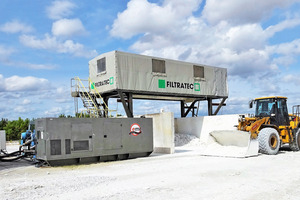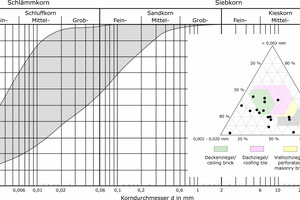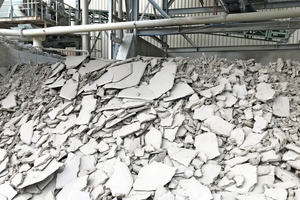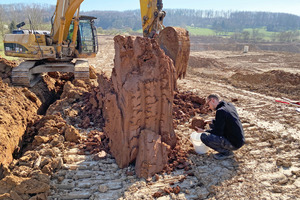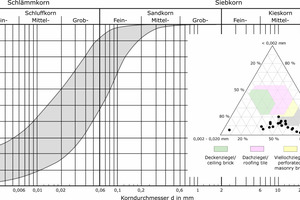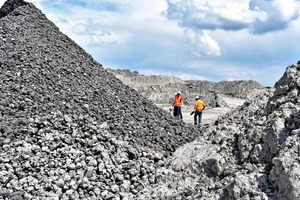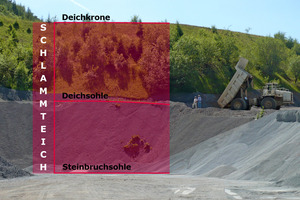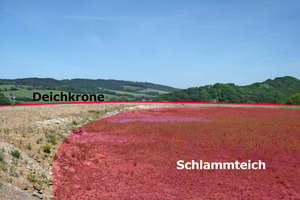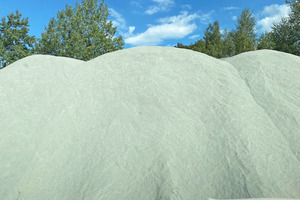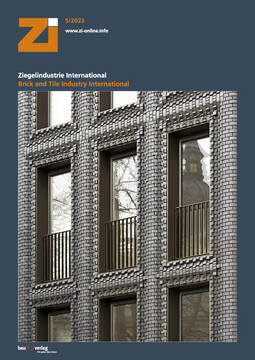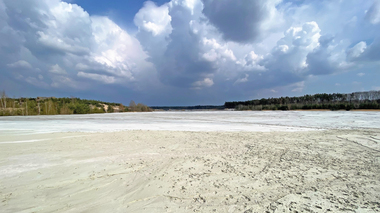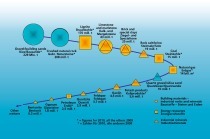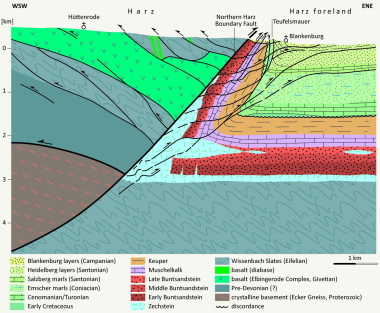Far-reaching transformation in the raw materials sector – What could new raw material concepts for the clay brick and tile industry look like?
The raw materials sector is undergoing far-reaching transformation. This has impacted the clay brick and tile industry, too. A diversification of its raw material base has become more important than ever. Key points from the paper presented at the Würzburg Brick and Tile Training Course 2022 are presented here.
1 The end of raw material extraction
The extraction of raw materials is no longer politically desirable. That is a bitter realization that many have not yet understood. They only wonder why it is becoming increasingly difficult year after year. Who hasn’t had to deal with it? Expert opinions on amphibian ladders, tunnels and retreats for sand lizards. Only recently, in Germany’s Sauerland region, permission for long-standing excavation at an important quarry was withdrawn because of ground-nesting plovers. With all the repercussions for the region and jobs. Now the already internationally operating raw materials group involved is going to invest abroad.
We are currently witnessing a fascinating highlight of this development in the German state of North-Rhine Westphalia, which is currently governed by a coalition of the Christian Democratic Union and Green political parties. Here, a raw materials tax on the extraction of sand and gravel has been included in the coalition agreement. But that’s not even the end of it all. It is only the beginning of the phase-out scenario. The policymakers want to get out of raw materials extraction completely. This situation hasn’t, however, just come out of the blue. It is simply a consequence of the national sustainability strategy that was already approved by the German government under Angela Merkel on 17 April 2002. The openly formulated goal was and is to drastically limit the consumption of primary resources and cut CO2. And naturally, the steadily rising CO2 levy has been specifically designed as stumbling block for many heavy clay ceramic plants.
2 Competing needs for raw materials?
Closely associated with the CO2 problem is the topic of metaclay. The cement industry must in future part from its traditional lime-marl base and is seeking alternatives for CO2-neutral production. In this connection, the calcination of clays could be one option. However, the required quality and quantity of clays are not even available. That was the outcome of a national clay research project commissioned by a leading building materials group in 2022 [1].
At every calcinator site, around 200 000 tonnes of clay will be needed and that over an operating period of at least ten years. The total demand of the cement industry is forecast to be around 10 million tonnes per annum. That matches pretty exactly the quantity also needed by the German brick and tile industry. It is not yet certain whether the project will in fact be realized by the cement industry. The first groups have already backpedalled. In future, cement may possibly come from India.
Moreover, the loss of the Ukrainian clays has led to a shortage of raw materials and considerable shifts in the market. The consequence were temporary supply bottlenecks and hefty price increases, especially for quality light-firing clays and washed kaolins.
3 Widening the raw materials base for clay bricks and tiles
Against the background of all these developments, the realization of new raw materials concepts appears more important than ever. As there is no patent remedy, the solution can only lie in a regionally specific diversification of the raw materials base. In this context, the increased use of clay mineral secondary resources and by-products is becoming increasingly important. The goal must be for producers to stretch their own reserves of raw materials as far as possible. By way of example, the following conceptual approaches were presented at the 59th Würzburg Brick and Tile Course in 2022:
3.1 Recycled clays from mineral washing
Recycled clays are washed and pressure-dewatered mineral sludges that exhibit a homogeneous structure and no grain fractions larger than 0.4 mm. They are free of unwanted coarse particles like wood, pyrite, lime or quartz aggregates. Recycled clays are used in brick bodies with up to 25 mass%. They exhibit a favourable to ideal particle size distribution and can substitute low- to medium-plasticity clays. They are used in the production of backing bricks, facing bricks, roofing tiles and tiles (»2).
In the non-metallic minerals industry, there are currently around 25 locations at which recycled clays are recovered as secondary resources from mineral washing. With a pronounced upwards trend, focuses lie in the German states of North Rhine-Westphalia, Saxony-Anhalt, Bavaria, Hesse and Rhineland-Palatinate. Recycled clays are recovered primarily from the mineral washing of siliciclastic rocks from massive limestone and vulcanites like basalt and rhyolite. The individual sites produce between 10 000 and 200 000 tonnes recycled clay per year. In total, over 750 000 tonnes material can be supplied.
3.2 Material excavated from tunnels
For the next few years, a large number of tunnel structures resulting in considerable volumes of excavated earth are planned all over Germany. These are primarily light rail and distance rail tunnels as well as motorway tunnels. Geologically the spectrum comprises the entire bandwidth from Mesozoic solid rocks to Cenozoic loose rocks. A good overview of the planned construction projects is provided in the STUVA tunnel construction statistics [2].
Of particular interest for the clay brick and tile industry are claystones from the Buntsandstein and Keuper. Mixed-grain earth excavated from tunnels is interesting if the clay fractions are sized and filtered according to the model of the DB’s Rastatt railway tunnel (»3). In this project, in the period from 2017 to 2020, large quantities of processed material excavated from the tunnel were supplied to backing brick plants. In contrast, material excavated from tunnels in carbonate and evaporite rock can generally not be considered.
3.3 Clays as top horizons
The idea of using clayey by-raw materials for the heavy clay industry is not completely new. But it can be implemented again and again project-specifically. Pioneer was the GDR, where the recovery of by-products of lignite mining was prescribed by law. Innumerable yellow brick buildings, for instance in the Halle-Leipzig region, were built from lignite clays. And we are still profiting from this. The currently largest clay pile in Central Europe with just under 8 million tonnes reserves comes from the former lignite surface mine Haselbach in the Leipzig mining district.
In Germany, there are currently around 1 500 quarries and 2 200 sand and gravel pits. According to estimates of the Bundesverband Mineralischer Rohstoffe MIRO (Federation of the German Mineral Resources Industry), 25 mill. tonnes overburden are produced per year during extraction [3]. Of this, a significant quantity is well- to excellently-suited as raw materials for clay bricks and roofing tiles. Well-known examples are the traditional HKC quarries near Ibbenbüren in the Upper Carboniferous and near Bramsche in the Upper Jurassic. Northwest German brick plants have been supplied with high-grade by-products/shales for many years from these quarries.
Currently under preparation are an early sintering Red Saliferous clay, which occurs as a top horizon on Zechstein dolomite Ca2 on the western edge of the Harz near Osterode. As a pronounced plastic clay with clear illite dominance and brilliant red firing colour, this clay is recommended primarily for rustic bricks. Brick properties under 950 °C (»4).
3.4 Clays from sand and gravel pits
As stagnant water sediments, clays can occur near to sand and gravel pits. These are often clay lenses or channel-like bodies that flare out laterally. Facial transitions to silts and fine sands are possible. Proper extraction, however, is associated with extensive analytical and technical requirements and can even be completely uneconomic. As here, no qualified proof of quantity can often be provided, use can only be recommended if it is possible to resort to substitute raw material. Irrespective of that, the quality of the clays can be excellent, their range stretching from red-firing to light-firing. Examples here are the clay from Osterfeld/Saxony-Anhalt, which is supplied as a pyrite-free additive component for light-firing bodies.
3.5 Granulated filler / rock flours
Rock fillers are mineral products in powder form with a supply size 0/90 µm. Characteristic is a fine sandy oversize up to d = 600 µm (»5). Rock fillers are produced at numerous quarries as by-products during processing. Depending on the size of the quarry, the quantities vary between 10 000 and 90 000 tonnes per annum. In petrographic terms, the rock fillers consist mainly of plutonites and vulcanites. A small quantity of rock fillers result from the processing of metamorphic and sedimentary solid rocks.
Rock fillers are used primarily as grog and drying additives. They contribute to the reduction of drying shrinkage. Also the minimization of the quartz inversion can be a motive for their use. Here basic to intermediary fillers like andesite and basalts can be especially recommended. Basic requirement for their use is homogeneous wetting, for instance, with the help of tubular screw conveyors. Already with around 5 mass% moisture content, fillers can be transported on standard lorry trailers and used dust-free in brick plants.
3.6 Intercalated clays from quarry ponds
The most important gravel deposits in Central Europe are found in the Rhine Rift Valley. With thicknesses up to 140 metres, thick clayey intermediate strata can be intercalated between the individual gravel strata. In the Fort Louis gravel plant/France, the intercalated clay is extracted with help of a powerful suction dredger and then stored in large piles on land.
It is a pronounced plastic clay with stiff consistency and a natural water content of around 30 mass%. Because of the extraction method, the clay exists in the form of fist-size roundish aggregates that might make you think of ball clay (»6). The clay is red-firing and has an illite-dominant clay mineral content of around 60 mass%.
3.7 Slurry pond under the regulation on dam safety
Truly astronomical figures: During the washing of sand and gravel, in Germany alone, around 15 mill. tonnes aluminosilicates in an aqueous suspension are produced annually. These are filled predominantly into unproductive slurry ponds. As clay substitutes, the minerals could contribute significantly to raw material supply [4,5]. For Central Europe, a quantity of at least 50 mill. tonnes solid material per year is estimated. On top of this come a good 150 mill. cubic metres freshwater, which is bound into the slurry year after year [6].
Some slurry ponds are so big that they are legally subject to the regulations on dam safety (»7a, 7b). However, the huge clay potential of old slurry ponds cannot generally be utilized for the heavy clay industry. That is essentially down to the completely inhomogeneous moisture distribution in these ponds. Whereas the surface has been largely dried, the deeper strata generally have a mushy-soft consistency. Secondly, considerable impurities caused by constant plant growth makes selective reclaiming uneconomic. The situation is different, however, for more recent slurry ponds with still largely liquid consistency [8]. Here the suspension can be easily pumped off and the material processed on mobile chamber filter presses to filter cake (»1).
3.8 By-products from slate production
During the production of slate chippings, very fine slate chippings in the size range 0.2 – 0.6 mm and slate flour in the grain size 0 – 0.2 mm are produced. In geological terms, these consist of Palaeozoic phyllitic and clay slate, which can be assigned to the Ordovician, Devonian and Carboniferous. On account of strong diagenetic overprinting, the clay mineral paragenesis is dominated by sericite and chlorite or illite and chlorite. Innercrystalline swelling clay minerals are absent. Their preferred use is considered to be as a low-quartz grog in the production of clay roofing tiles, clinker bricks and clay pavers [9]. Fine slate chippings and slate flour are interesting in respect of energy savings in preparation and drying (»8). Depending of the size of the site, the quantities produced annually vary between 10 000 and 90 000 tonnes.
4 Final remarks
The heavy clay industry is facing the biggest challenges for decades. Excavation processes are becoming increasingly difficult as raw material extraction is no longer politically desirable. The task is therefore to diversify its raw material base and to stretch out its own raw material base for longer. The raw materials presented can be used to selectively improve product properties or simplify the production process. As no patent remedy is available, the solution can, however, only be found with a regionally individual approach.

